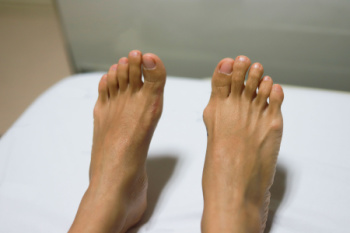Items filtered by date: September 2024
Football Players and Ankle Injuries

Football players are at high risk for ankle injuries due to the sport's physical demands, including rapid direction changes, running, and jumping. Sprains are one of the most common ankle injuries, particularly among running backs and receivers. These sprains often occur when the ankle is twisted or stepped on during play, causing damage to ligaments. High ankle sprains, which involve the ligaments above the ankle, are more severe and take longer to heal than lower ankle sprains. If not treated properly, ankle injuries can lead to long-term problems like chronic instability and pain. This may impact a player's performance and ability to participate in future games. A podiatrist can help by diagnosing the injury, recommending proper treatment, and suggesting ways to prevent future injuries through bracing or rehabilitation exercises. If you have an ankle injury as a result of playing football, it is suggested that you make an appointment with a podiatrist.
Sports related foot and ankle injuries require proper treatment before players can go back to their regular routines. For more information, contact Mohammad R. Parsa, DPM of Madison Foot Clinic. our doctor can provide the care you need to keep you pain-free and on your feet.
Sports Related Foot and Ankle Injuries
Foot and ankle injuries are a common occurrence when it comes to athletes of any sport. While many athletes dismiss the initial aches and pains, the truth is that ignoring potential foot and ankle injuries can lead to serious problems. As athletes continue to place pressure and strain the area further, a mild injury can turn into something as serious as a rupture and may lead to a permanent disability. There are many factors that contribute to sports related foot and ankle injuries, which include failure to warm up properly, not providing support or wearing bad footwear. Common injuries and conditions athletes face, including:
- Plantar Fasciitis
- Plantar Fasciosis
- Achilles Tendinitis
- Achilles Tendon Rupture
- Ankle Sprains
Sports related injuries are commonly treated using the RICE method. This includes rest, applying ice to the injured area, compression and elevating the ankle. More serious sprains and injuries may require surgery, which could include arthroscopic and reconstructive surgery. Rehabilitation and therapy may also be required in order to get any recovering athlete to become fully functional again. Any unusual aches and pains an athlete sustains must be evaluated by a licensed, reputable medical professional.
If you have any questions please feel free to contact our office located in Madison, MS . We offer the newest diagnostic and treatment technologies for all your foot and ankle needs.
Wounds That Don't Heal Need to Be Checked
Foot Pain Caused by Sesamoiditis

Sesamoiditis is a condition that causes pain beneath the base of the big toe. It is primarily due to inflammation or injury to the sesamoid bones, which are two small bones located under the first metatarsal head. Sesamoiditis is common among dancers, joggers, people with high-arched feet, or those who frequently wear high heels. The pain associated with sesamoiditis often intensifies during activities like walking, especially when barefoot or wearing certain shoes. It may be accompanied by swelling, warmth, or redness in the affected area. A podiatrist can diagnose sesamoiditis through a thorough examination of the foot, sometimes using imaging tests to rule out fractures or arthritis. Treatment typically involves reducing pressure on the sesamoid bones through the use of orthotics, offloading pads, or appropriately supportive footwear. If you are experiencing pain under the big toe, it is suggested that you schedi;e an appointment with a podiatrist for an exam, diagnosis, and treatment options.
Sesamoiditis is an unpleasant foot condition characterized by pain in the balls of the feet. If you think you’re struggling with sesamoiditis, contact Mohammad R. Parsa, DPM of Madison Foot Clinic. our doctor will treat your condition thoroughly and effectively.
Sesamoiditis
Sesamoiditis is a condition of the foot that affects the ball of the foot. It is more common in younger people than it is in older people. It can also occur with people who have begun a new exercise program, since their bodies are adjusting to the new physical regimen. Pain may also be caused by the inflammation of tendons surrounding the bones. It is important to seek treatment in its early stages because if you ignore the pain, this condition can lead to more serious problems such as severe irritation and bone fractures.
Causes of Sesamoiditis
- Sudden increase in activity
- Increase in physically strenuous movement without a proper warm up or build up
- Foot structure: those who have smaller, bonier feet or those with a high arch may be more susceptible
Treatment for sesamoiditis is non-invasive and simple. Doctors may recommend a strict rest period where the patient forgoes most physical activity. This will help give the patient time to heal their feet through limited activity. For serious cases, it is best to speak with your doctor to determine a treatment option that will help your specific needs.
If you have any questions please feel free to contact our office located in Madison, MS . We offer the newest diagnostic and treatment technologies for all your foot and ankle needs.
Facts About Broken Toes

A broken toe, or toe fracture, occurs when one of the bones in the toe is cracked or shattered due to trauma or excessive stress. Common causes include stubbing the toe, dropping heavy objects on it, or repetitive pressure from ill-fitting shoes. Symptoms typically involve pain, swelling, bruising, and difficulty moving the toe. In some cases, the toe may appear deformed or misaligned. For mild relief, it is vital to rest the injured foot and avoid putting weight on it. Pain may be managed by taking mild pain relievers. Keeping the toe elevated and using a buddy tape technique, where the injured toe is taped to an adjacent toe for support, can also assist in recovery. If you have broken your toe, it is suggested that you promptly schedule an appointment with a podiatrist who can make an accurate diagnosis and provide treatment.
A broken toe can be very painful and lead to complications if not properly fixed. If you have any concerns about your feet, contact Mohammad R. Parsa, DPM from Madison Foot Clinic. our doctor will treat your foot and ankle needs.
What to Know About a Broken Toe
Although most people try to avoid foot trauma such as banging, stubbing, or dropping heavy objects on their feet, the unfortunate fact is that it is a common occurrence. Given the fact that toes are positioned in front of the feet, they typically sustain the brunt of such trauma. When trauma occurs to a toe, the result can be a painful break (fracture).
Symptoms of a Broken Toe
- Throbbing pain
- Swelling
- Bruising on the skin and toenail
- The inability to move the toe
- Toe appears crooked or disfigured
- Tingling or numbness in the toe
Generally, it is best to stay off of the injured toe with the affected foot elevated.
Severe toe fractures may be treated with a splint, cast, and in some cases, minor surgery. Due to its position and the pressure it endures with daily activity, future complications can occur if the big toe is not properly treated.
If you have any questions please feel free to contact our office located in Madison, MS . We offer the newest diagnostic and treatment technologies for all your foot and ankle needs.
Recognizing the Early Signs of Bunions

Early signs of bunion formation often begin subtly, with symptoms such as redness, swelling, and tenderness surronding the base of the big toe. As the bunion progresses, the big toe may start to lean toward the other toes, creating a visible bump on the side of the foot. Over time, you might also notice thickened skin or calluses developing due to the increased pressure on the affected area. Simple adjustments like avoiding wearing ill-fitting shoes and high heels, while opting for wide, comfortable, soft-soled shoes, can help to manage symptoms. A podiatrist may recommend placing spacers between the toes to prevent rubbing, covering the bunion with pads, and stretching calf muscles to improve joint alignment. This foot doctor also may prescribe orthotic devices to slow the progression of the bunion and improve your foot health. If you believe a bunion is forming on your toe, it is suggested that you schedule an appointment with a podiatrist for an evaluation and proactive treatment options.
If you are suffering from bunion pain, contact Mohammad R. Parsa, DPM of Madison Foot Clinic. our doctor can provide the care you need to keep you pain-free and on your feet.
What Is a Bunion?
Bunions are painful bony bumps that usually develop on the inside of the foot at the joint of the big toe. As the deformity increases over time, it may become painful to walk and wear shoes. Women are more likely to exacerbate existing bunions since they often wear tight, narrow shoes that shift their toes together. Bunion pain can be relieved by wearing wider shoes with enough room for the toes.
Causes
- Genetics – some people inherit feet that are more prone to bunion development
- Inflammatory Conditions - rheumatoid arthritis and polio may cause bunion development
Symptoms
- Redness and inflammation
- Pain and tenderness
- Callus or corns on the bump
- Restricted motion in the big toe
In order to diagnose your bunion, your podiatrist may ask about your medical history, symptoms, and general health. Your doctor might also order an x-ray to take a closer look at your feet. Nonsurgical treatment options include orthotics, padding, icing, changes in footwear, and medication. If nonsurgical treatments don’t alleviate your bunion pain, surgery may be necessary.
If you have any questions, please feel free to contact our office located in Madison, MS . We offer the newest diagnostic and treatment technologies for all your foot care needs.

